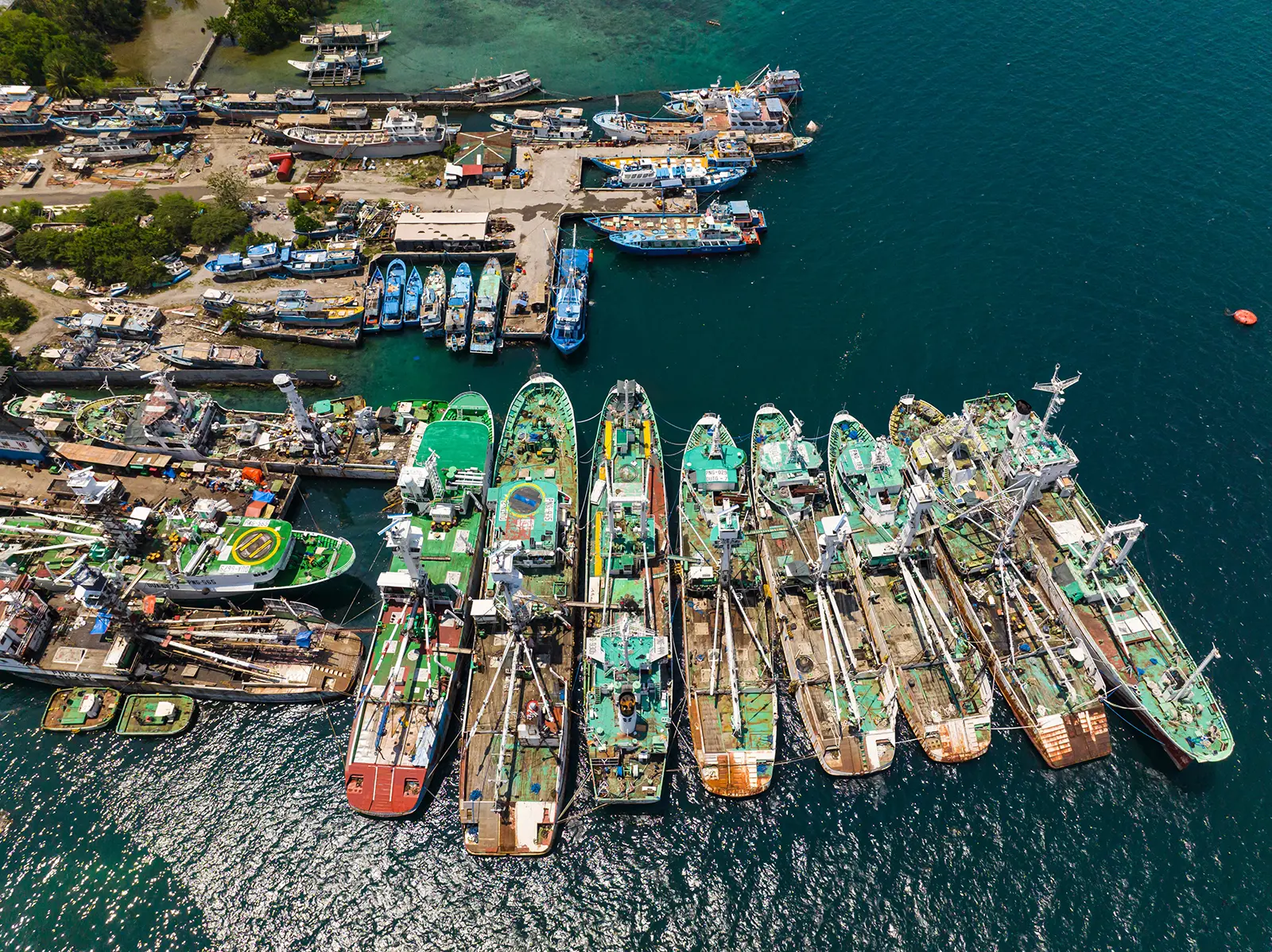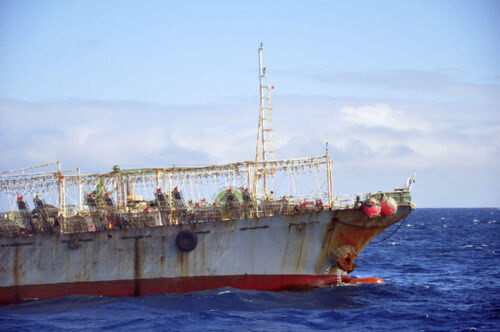Vessel Viewer informs decision-making and operational planning for ports, insurance and seafood supply chains
Few industries are as hard to monitor as commercial fishing, and few products as hard to trace as seafood. The challenges range from knowing a fishing vessel’s identity and what they are doing on the ocean’s vast expanses—and the history of that ship—to validating the origin of catch and tracking it from sea to port to processing, wholesale and eventual retail sale.
Historically, some of that information has been available but not in one place, and definitely not in any consistent or easy-to-access format. To help solve that, Global Fishing Watch and TMT partnered to develop Vessel Viewer, an online tool that aggregates data from a range of public sources on a vessel’s current and historic identity, authorizations and activity. Over the past two years Vessel Viewer has been tested and refined with partners through several pilot projects focused on port inspections, fisheries enforcement, insurance and seafood supply chains.

FishWise, a Santa Cruz, California-based nonprofit, conducts verification activities and tracebacks to help companies understand environmental, traceability and social responsibility risks—including illegal, unreported and unregulated (IUU) fishing—within their supply chains. They have been piloting the tool with Global Fishing Watch as part of a project with partners Stanford Center for Ocean Solutions and the World Economic Forum’s Friends of Ocean Action to see how vessel analytics can improve seafood due diligence efforts..
Lindsay Ceron, senior project director at FishWise, said Vessel Viewer is a valuable tool in the “first mile” of the seafood supply chain, the time from when catch is landed on a vessel until it is transferred to another vessel or at port.
“That is generally an opaque part of seafood supply chains,” Ceron said. “Having access to vessel-level information that complements what Global Fishing Watch’s traditional map provides gives FishWise and our partners better transparency into their supply chains and allows us to provide companies with more tailored, robust recommendations on how to prioritize and address any risks found.”
She added that Vessel Viewer has helped FishWise significantly boost efficiency. “For certain supply chains, like shelf-stable tuna, there can be upwards of 100 vessels that need analyzing, which is time-intensive. Vessel Viewer’s information and insights can quickly provide robust vessel-level insights in one platform.”
Ceron cited Vessel Viewer’s features, including data on AIS coverage rates, flag changes, transshipment events, port visits and activity in marine protected areas, as especially useful in the due diligence that FishWise conducts. The tool gives the organization greater transparency and insights about more vessels at once and helps FishWise to produce “meaningful and actionable recommendations” to support partners’ seafood programs.
While FishWise has traditionally used many of the datasets that Vessel Viewer leverages, this is the first time the organization has all of those disaggregated datasets in one place, which has helped FishWise streamline its IUU fishing risk assessments.

Having detailed vessel insights also allows for deeper supplier engagement and better-informed discussions between seafood companies and their suppliers. By improving risk assessments and supplementing existing processes with vessel-level insights, companies can transition from spending most of their resources on assessing risk to directing efforts to address and mitigate those risks via due diligence activities.
The insurance company Gard also piloted Vessel Viewer as part of a project with Global Fishing Watch, TMT and the Ocean Risk and Resilience Action Alliance to support insurance underwriters in making more informed decisions on the fishing vessels they insure. Marius Schønberg, vice president, loss prevention at Gard, noted that “Insuring fishing vessels is seen as risky as it can be challenging to access information needed to properly assess them.” He added that Vessel Viewer is helping the company address that problem by “putting multiple data fields together, which gives us a better understanding of the risk and helps us do a better risk assessment.”
Gard is a signatory to the Statement on Sustainable Marine Insurance, a commitment by marine insurers to tackle IUU fishing through education, awareness building, risk management and insurance underwriting.
Gard uses Vessel Viewer to research specific vessels and owners seeking insurance. “Very often a vessel look-up triggers questions that we would like to raise to the shipowner in a meeting,” Schønberg said. Although the tool doesn’t produce a clear answer about a vessel’s insurability, “it could indicate that the fishing operation based on the behavior of the vessel is somewhat strange—and should be checked.”
He added that Vessel Viewer gives Gard “more data to make sure we do a better risk assessment in the underwriting process. For us as an insurer, it is not acceptable to have vessels in our portfolio engaged in IUU fishing.” To prevent that from happening, he added, “We need all the data we can get, both for new and existing vessels.”

Vessel Viewer is also immensely useful to port officials, especially in regions commonly targeted by IUU fishers. Recognizing the critical importance of robust port controls, Global Fishing Watch and TMT set out on a program, “Intelligence-led fisheries port controls,” to support a risk-based approach to implementation of the FAO Agreement on Port State Measures, with a focus on the the Advance Request for Port Entry process, a cornerstone of the Agreement.
Vessel Viewer was developed as part of this program to provide port inspectors with up-to-date information on a vessel’s identity and activity, and serve as part of the toolbox that fisheries agents use when assessing a vessel’s port entry request. It was first piloted in November 2021 as part of a partnership between Global Fishing Watch and TMT with four African nations and a regional fisheries organization – Senegal, Ghana, Côte d’Ivoire, Kenya and the Fisheries Committee for the West Central Gulf of Guinea.
Shadrack Machua, assistant director of fisheries for Kenya’s Fisheries Service said that the tool’s wide range of information on vessels from multiple sources helps “ensure access to complete and reliable vessel data to aid in risk assessments and in vetting foreign fishing vessels for port access and potential registration.”
Machua specifically cited the ability to search for vessels by name, Marine Mobile Service Identity number, International Maritime Organization number, or call sign. Aside from returning a wealth of detail from those searches, Vessel Viewer also allows users to see marine protected area boundaries, RFMO Convention Areas and exclusive economic zones. And users can save information for viewing offline.
Global Fishing Watch will continue to work on improvements to Vessel Viewer to ensure our tools and platforms remain a benchmark in ocean management, providing insights that bring greater transparency to fisheries sectors and helping to inform decisions to bolster ocean governance.


